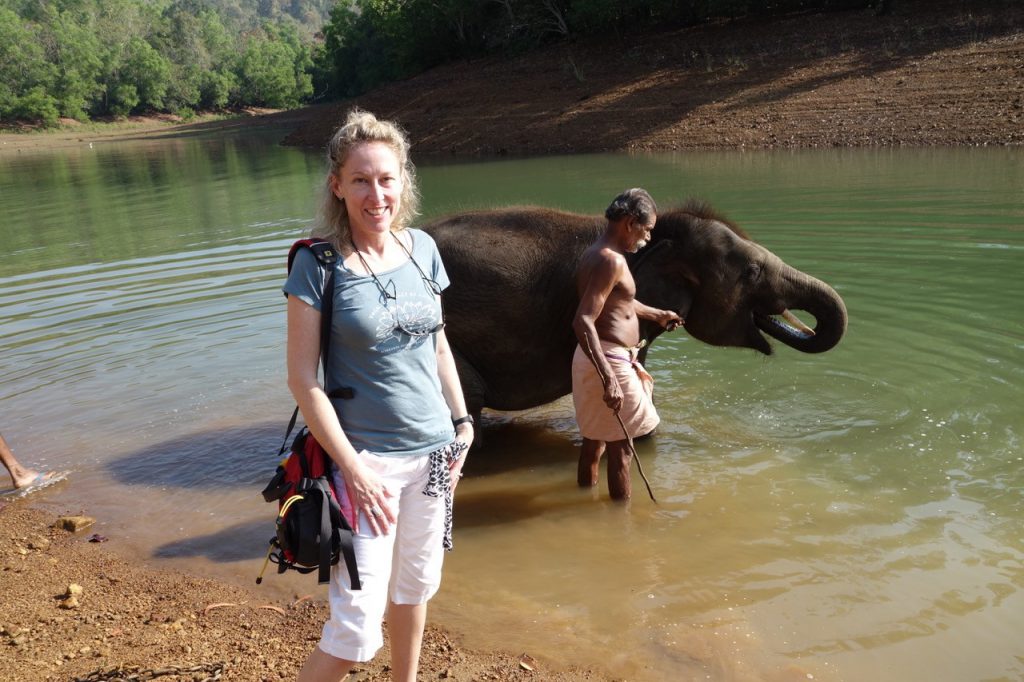In today’s guest post, we’re happy to introduce you to CF Yogi’s newest instructor Suzanne Joyce, RYT500 yoga teacher, 57-year old adult with CF, and double-lung transplant survivor! Starting on Friday October 2, Suzanne will be joining us to teach a weekly class in iRest® Yoga Nidra– a wonderfully accessible form of guided meditation that can help with relieving stress, recovering from trauma, and managing anxiety and depression. Read on to learn about her experience with iRest, and how it may help you, too.

Living a life with cystic fibrosis is often stressful and overwhelming. It’s the daily-ness of it all that wears on me. Keeping up with all the treatments, GI and sinus issues, eating well, exercising – if you have CF like me, you know this list goes on. Even in the best of times, the burdens of CF can easily develop into chronic stress, anxiety, and insomnia. And if anything goes wrong, a traumatic experience can stick with you long after immediate danger has passed. It’s also important to remember that CF doesn’t make you immune from other situations that create stress, like work, finances, family, politics, and the environment in which we live.
There are many ways in which stress reveals itself, and there are many ways to cope with it. In this blog and my upcoming classes, I’d like to share one coping method that has proven helpful to me – a guided meditation practice known as iRest yoga nidra. I first experienced it in 2011, and soon after I took an iRest teacher training with the intention simply to deepen my own practice. I quickly found that I wanted others to have the experience of iRest and I began to teach it at various yoga studios. I then wanted to learn more, and now have a Level II certification as an iRest® Yoga Teacher.
What is iRest yoga nidra?
Integrative Restoration, or iRest, is an adaptation of yoga nidra, an ancient yogic practice of meditation. Through this practice you are not only relaxing but learning tools that promote resilience, health, and a sense of well-being, something all of us with CF can benefit from.
Yoga means “union” or “non-separation” and nidra means “sleep” or “changing states of consciousness.” Yoga nidra means a state of mind between sleep and wakefulness. During yoga nidra, you enter a profound state of receptive relaxation, all the while remaining totally aware and alert throughout the practice.
The iRest form of yoga nidra I practice and teach has been developed by Richard Miller, PhD, a clinical psychologist, yogic scholar, and spiritual teacher. iRest combines traditional yogic practice with Western psychology and neuroscience. iRest Yoga nidra can help us to accept life as it is, but it is more than just an affirmation or positive thinking—it is change on a deeper level.
My Personal Experience with iRest
I personally use iRest to deeply relax and to help with anxiety and depression. I use it as a guided meditation that I keep on my mobile devices so I can listen to it anywhere. Over time I’ve learned to use parts of iRest on my own to help me get through anxious moments or even a panic attack. I’ve used iRest on the subway, in a hospital bed, sitting by the pool, and before dealing with something or someone that is making me anxious or fearful. Sometimes I use it to help me fall asleep or return to sleep if I’ve awakened in the middle of the night.
I am particularly grateful that I learned this practice prior to my double-lung transplant. My anxiety and insomnia were extreme while I was in the hospital during the initial phase of recovery. Practicing the body sensing and breath work steps took the edge off and helped me to feel a bit more grounded.

Is there any science behind yoga nidra?
Evidence-based benefits of iRest include:
- Inducing profound relaxation in your body and mind
- Reducing PTSD, insomnia, stress, chronic pain, and chemical dependency
- Resolving personal and interpersonal problems
- Neutralizing and overcoming anxiety, fear, anger and depression
Practicing iRest releases oxytocin and activates the parasympathetic nervous system, which antidotes cortisol and calms the fight-flight sympathetic nervous system, restoring balance between the parasympathetic and the sympathetic.
Our neural networks create automatic and engrained emotional reactions. For example, if I felt overwhelmed about getting everything done in a given day or felt scared about an upcoming medical procedure I would default to feeling anxious. For someone else this could result in feeling anger. If we can disengage old habits of neural firing from creating their automatic and engrained emotional reactions, such as depression or anxiety, we can reduce mental suffering. This shift in the focus of attention—the way we use the mind to channel the flow of energy and information through the various circuits of the brain—changes the pattern of activity in the brain. With repetition, a mindful practice such as iRest can create intentional states of brain activation that may ultimately become new neural pathways.
For more information on research at: www.irest.org/irest-research
What happens during an iRest practice?
First and foremost, know that there is no right or wrong way to practice iRest! You are guided through various stages of iRest, each step building on the one before. You may either lie down on a couch or bed or sit in a comfortable chair or recliner with your eyes closed. In my classes, I will guide you through a body sensing meditation and some breath work. At this point your body is relaxed and the mind will follow. We will focus on sensations in your body such as warmth/coolness or tension/relaxation. We will also spend time sensing an emotion of your choosing or perhaps a belief that you hold to be true about yourself. It is at this point where we can learn to use tools that promote resilience, health and a sense of well-being. With practice these tools can be used “off the mat” in our daily lives whenever a stressful situation arises or we have a need or desire to be resilient or at peace within ourselves.
There are a couple of questions that I often get, the most common one is, “Do I need “yoga” experience to do this?” Not at all! iRest doesn’t involve physical movement so it is accessible to all ability levels. If you have practiced yoga before, you’ll find that iRest is similar to a long savasana.
Another common question I get is, “How is yoga nidra different than hypnosis?” To put it succinctly,during hypnosis you are led into a deep sleep where the brain is completely shut down. In contrast, during yoga nidra the brain is completely awake while the body rests.
Bringing iRest to the CF Community

I experimented with teaching over the phone to the CF community over the years, but it wasn’t until the COVID-19 pandemic that I began independently offering free online classes to the CF community. A few months ago, I began to offer two Zoom practices each week, with one specifically designed to support a good night’s sleep. While I have enjoyed teaching independently, I am excited to now be joining forces with CF Yogi with this Friday class so that together we can bring iRest Yoga Nidra to even more people in the CF community!
The benefits of meditation and iRest are so needed right now. I hope you’ll join me on Fridays in October at 12 PM Pacific / 3 PM Eastern for this wonderfully relaxing and centering practice. You don’t even have to turn your camera on if you don’t want to – just close your eyes and listen. If you can’t make the live class time but want to give it a try, I encourage you to register anyway so you’ll receive the audio recording link that you can listen to on your own when you need to de-stress.
A suggested donation of $10/class helps to support CF Yogi, but there is no obligation to donate. Times are tough so please just pay what you can. I am looking forward to meeting you!

